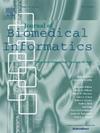从小样本有效的斜视诊断:利用空间特征提高准确性。
IF 4
2区 医学
Q2 COMPUTER SCIENCE, INTERDISCIPLINARY APPLICATIONS
引用次数: 0
摘要
斜视是一种常见的眼科疾病,早期诊断对预防视力损害和立体视觉丧失至关重要。然而,传统的斜视诊断方法往往依赖于专业的眼科设备和训练有素的人员,限制了斜视诊断的广泛可及性。计算机辅助斜视诊断是一种有效的、广泛应用的技术,可以帮助临床医生进行临床诊断,提高诊断效率。为了解决这个问题,我们设计了一个有效的斜视诊断模型RIS-MLP,该模型基于Hirschberg测试在自然光条件下捕获的少量正面面部图像样本。RIS-MLP结合光反射点检测和虹膜检测模块,即使在噪声和遮挡条件下也能准确提取关键空间特征。优化后的空间特征策略进一步提高了分类模块的性能。为了验证RIS-MLP的优越性,我们进行了直接和间接的对比实验。间接比较表明,RIS-MLP在样本效率方面具有优势。虽然直接比较表明RIS-MLP可以在一定程度上缓解过拟合,而且RIS-MLP及其变体(例如RIS-SVM)在我们的嘈杂和不平衡数据集上的表现优于最先进的模型。本文章由计算机程序翻译,如有差异,请以英文原文为准。

Efficient strabismus diagnosis from small samples: Harnessing spatial features for improved accuracy
Strabismus is a common ophthalmological condition, and early diagnosis is crucial to preventing visual impairment and loss of stereopsis. However, traditional methods for diagnosing strabismus often rely on specialized ophthalmic equipment and trained personnel, limiting the widespread accessibility of strabismus diagnosis. Computer-aided strabismus diagnosis is an effective and widely used technology that assists clinicians in making clinical diagnoses and improving efficiency. To address this, we designed an efficient strabismus diagnosis model, RIS-MLP, based on a small number of samples derived from frontal facial images captured under natural lighting conditions via the Hirschberg test. The RIS-MLP combines light reflex point detection and iris detection modules to accurately extract key spatial features even under noisy and occluded conditions. The optimized spatial feature strategies further enhances the performance of the classification module. To validate the superiority of RIS-MLP, we conducted both direct and indirect comparative experiments. Indirect comparisons demonstrate that the RIS-MLP has advantages in terms of sample efficiency. While direct comparisons show that the RIS-MLP can mitigate overfitting to a certain extent, and the RIS-MLP along with its variants (e.g., RIS-SVM) have outperformed state-of-the-art models on our noisy and imbalanced dataset.
求助全文
通过发布文献求助,成功后即可免费获取论文全文。
去求助
来源期刊

Journal of Biomedical Informatics
医学-计算机:跨学科应用
CiteScore
8.90
自引率
6.70%
发文量
243
审稿时长
32 days
期刊介绍:
The Journal of Biomedical Informatics reflects a commitment to high-quality original research papers, reviews, and commentaries in the area of biomedical informatics methodology. Although we publish articles motivated by applications in the biomedical sciences (for example, clinical medicine, health care, population health, and translational bioinformatics), the journal emphasizes reports of new methodologies and techniques that have general applicability and that form the basis for the evolving science of biomedical informatics. Articles on medical devices; evaluations of implemented systems (including clinical trials of information technologies); or papers that provide insight into a biological process, a specific disease, or treatment options would generally be more suitable for publication in other venues. Papers on applications of signal processing and image analysis are often more suitable for biomedical engineering journals or other informatics journals, although we do publish papers that emphasize the information management and knowledge representation/modeling issues that arise in the storage and use of biological signals and images. System descriptions are welcome if they illustrate and substantiate the underlying methodology that is the principal focus of the report and an effort is made to address the generalizability and/or range of application of that methodology. Note also that, given the international nature of JBI, papers that deal with specific languages other than English, or with country-specific health systems or approaches, are acceptable for JBI only if they offer generalizable lessons that are relevant to the broad JBI readership, regardless of their country, language, culture, or health system.
 求助内容:
求助内容: 应助结果提醒方式:
应助结果提醒方式:


